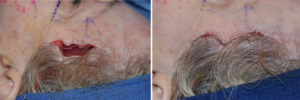Temporal implants offer the only method of permanent temporal augmentation…that is also easily reversible. Placed in the subfascial plane on top of the anterior temporalis muscle, there is no risk of facial nerve injury nor visible edges of the implant.The skin incision to place them is done back behind the temporal hairline so it is easily hidden in the hair. This also provides an easy point of access to the subfascial plane.
But one can also place temporal implants through a hairline incision as well. I recently had a patient who came in for a variety of facial procedures including temporal implants. She happened to have had a facelift by another surgeon where a hairline incision was carried away from the ear up along the front edge of the temporal hairline. Thus an existing temporal hairline scar was present.



While the hairline or pretrichial approach to temporal implants does place the fine line scar in a more visible location, it does have several advantages. It offers easier access to the subfascial pocket and allows visible assessment of the implant placement. Because there is less tissue disruption than when the incision is placed further back in the temporal hair, the procedure is also less ‘traumatic’.
For the properly selected patient, the hairline approach to temporal implant placement could be a preferred technique.
Dr. Barry Eppley
Indianapolis, Indiana


